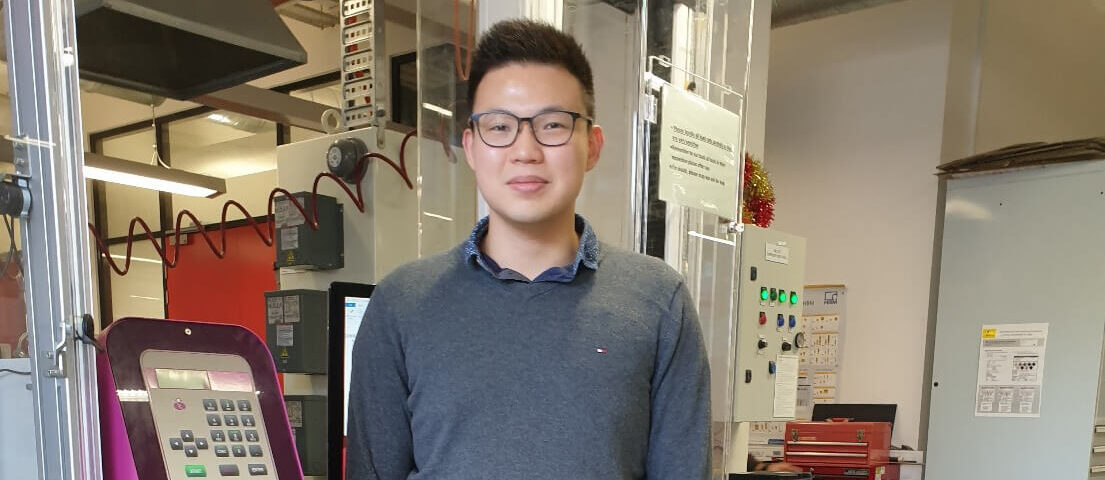PhD graduation – Dr. Veldyanto Tanulia

Hosting NSW Chief Scientist at AMAC
March 7, 2022MOUs Signed
May 2, 2022PhD graduation – Dr. Veldyanto Tanulia
One of our PhD students, Dr. Veldyanto Tanulia has successfully completed his PhD, supervised by Prof. Gangadhara Prusty. Co-supervisors are Assoc Prof. Garth Pearce, Dr. John Wang and Dr. Alan Baker. This PhD research was a collaborative project between ARC Training Centre for Automated Manufacture of Advanced Composites (AMAC) at the University of New South Wales (UNSW) and Defence Science and Technology (DST) Group.The research evaluates the applicability of a damage slow growth management strategy to bonded joints/patch repairs of primary aircraft structures through both experimental and computational study. The investigation was carried out first by 2-D strip specimen assessment and finally using 3-D analysis of wide bonded metal joint. The double overlap tapered end specimen (DOTES) specimen which represents both disbond tolerant zone and safe-life zone in bonded patch repair was investigated first through a detailed computational and experimental investigation. The residual static strength of the joint as a function of disbond length was established using finite element modelling based on the characteristic distance approach. The virtual crack close technique (VCCT) approach was utilised to assess the strain energy release rates (SERRs) as a function of disbond crack length. Fatigue tests of the DOTES coupon specimen were conducted to investigate the entire process of disbond growth from initiation up to ultimate failure of the joint. The measured disbond growth rates were correlated with the SERRs using a modified Paris law that enabled prediction of joint fatigue life. The fatigue test results indicated that for a joint having a sufficient static strength safety margin under a typical fatigue loading that would propagate disbond, the disbond growth would remain stable within a particular length range. Thus, the slow growth approach would be feasible for bonded joints/patch repairs if the patch is designed to be sufficiently large to allow extended damage propagation. Cohesive zone element (CZE) technique was utilised to assess the SERRs and estimate the disbond growth of 3-D wide bonded metal joint analysis. The impact of local or partial width disbond (load shedding effect) was investigated in detail. The results indicate that for a local or part width disbond, some load was redistributed to the adjacent regions (load shedding effect) that causes a slower disbond growth and accordingly longer fatigue life compared to the full width disbond.
The key outcomes from this research are:
- accurate prediction of the disbond growth behaviour in bonded patch repairs through the developed generic patch repair specimen i.e DOTES,
- fatigue life prediction of the joints has been established through modified Paris law, by conducting numerical integration and
- the effect of initial disbond size in 3-D wide bonded metal joint specimen was investigated through computational assessment using a cohesive fatigue model.
Publications of Dr. Tanulia during his PhD
- V. Tanulia, J. Wang, G. M. Pearce, A. Baker, M. David, and B. G. Prusty, “Damage Tolerance of Bonded Patch Repairs for Primary Aircraft Structures,” 4th UNSW Engineering Postgraduate Research Symposium, Sydney, 26-27 September 2018.
- V. Tanulia, J. Wang, G. M. Pearce, A. Baker, M. David, and B. G. Prusty, “Disbond Growth Assessment for Bonded Joints and Patch Repairs of Primary Airframe Structures,” in International Conference on Composite Materials (ICCM-22), Melbourne, Australia, 2019. URL: https://search.informit.org/doi/10.3316/INFORMIT.883506669529736
- V. Tanulia, J. Wang, G. M. Pearce, A. Baker, M. David, and B. G. Prusty, “A Procedure to Assess Disbond Growth and Determine Fatigue Life of Bonded Joints and Patch Repairs for Primary Airframe Structures,” International Journal of Fatigue, p. 105664, 2020. URL: https://doi.org/10.1016/j.ijfatigue.2020.105664
- V. Tanulia, J. Wang, G. M. Pearce, A. Baker, P. Chang, and B. G. Prusty, “Experimental and Computational Assessment of Disbond Growth and Fatigue Life of Bonded Joints and Patch Repairs for Primary Airframe Structures,” International Journal of Fatigue, 2022. URL: https://www.sciencedirect.com/science/article/pii/S0142112322000561
- V. Tanulia, J. Wang, G. M. Pearce, A. Baker, P. Chang, and B. G. Prusty, “Static Strength and Fatigue Life Prediction of Bonded Joints/Patch Repairs Used in Primary Aircraft Structures,” in the 5th Australasian Conference on Computational Mechanics (ACCM 2021), Sydney, Australia, 13 – 15 December 2021. Coffee

